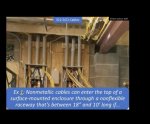Here's some examples of when to count and not count the neutral as a current carrying conductor or CCC:
3Ø- 208Y/120 or 480Y/277 volt system-different circuit types:
A) 2 wire circuit w/ 1 ungrounded, 1 neutral = 2 CCC's
B) 3 wire circuit w/ 2 ungrounded, 1 neutral = 3 CCC's
C) 4 wire circuit w/ 3 ungrounded, 1 neutral = 3 CCC's*
Notes:
A) A normal 2 wire circuit has equal current flowing in each of the circuit conductors so they both count as CCC's.
B) In this circuit the neutral current will be nearly equal to the current in the ungrounded conductors so the neutral counts as a CCC
C) In this circuit the neutral will only carry the imbalance of the current between the three ungrounded conductors so it is not counted as a CCC, with an exception, *if the current is more than 50% nonlinear (see below for NEC article 100 definition) then the neutral would count as a CCC.
1Ø- 120/240 volt system-different circuit types:
D) 2 wire circuit w/ 1 ungrounded, 1 neutral = 2 CCC's
E) 3 wire circuit w/ 2 ungrounded, 1 neutral = 2 CCC's
Notes:
D) A normal 2 wire circuit has equal current flowing in each of the circuit conductors so they both count as CCC's.
E) In this circuit the neutral will only carry the imbalance between the two ungrounded conductors so the neutral is not counted as a CCC.
Nonlinear Load. A load where the wave shape of the steady-state current does not follow the wave shape of the applied voltage.
Informational Note: Electronic equipment, electronic/electric-discharge lighting, adjustable-speed drive systems, and similar equipment may be nonlinear loads.


